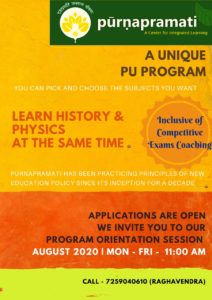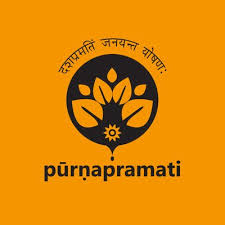Bio Diversity Park: Field Trip
In a dense metropolis like ours, with people of good affluence residing, every sort of human’s taste is served. Our place is a platform for any kind of occupation or recreation. The market pleases us with a countless variety of items supporting our every single activity. The proverb ‘Variety is the spice of life’ is our doctrine and it rules. But the eco-concerned, sensing the damage being continuously caused to the environment, grieve over the situation and often ask “Why doesn’t anybody realise that there is also the spice of Bio variety highly necessary on earth?” Some of them desperately try out ways to contribute to the conservation of Bio diversity and habitats. The result of one such effort is the Bio-diversity park inside Bangalore university campus, which Purnapramati visited as a field trip on 8th August, 2013.
The park is a novel venture conceived by the university’s previous vice chancellor K N Siddappa and planned by retired environment secretary and forest officer A N Yellappa Reddy. The 800 acre park consists largely of indigenous tree species native to western ghats. It is also known for its medicinal gardens developed by invoking ancient Indian techniques and modern rain water and soil conservation techniques.
In the activities of our trip, we were accompanied by Sri Yellappa Reddy, environmentalist and journalist Sri Nagesh Hegde, environmentalist and educationalist Sri Suresh Kulkarni, Professor of Ecology at IISc Sri Harish Bhat, Prof of Geology at Bangalore university Sri Renuka Prasad, folk artist Sri Bandagadde Radha Krishna, former Professor of NCERT Sri M Nagaraj accompanied us.
In a short session at the beginning, Sri Kulkarni entertained children with a few free hand drawings and two hand symmetry drawings and enlightened children about the fundamental skills essential to be a good observer of environment. Some of the examples he evoked are here.
– When we need to check whether a given plant is a monocot or dicot, check its leaves without going to its seed. If the leaves have parallel venation, it is a monocot and if they have a reticulate venation, it is a dicot.
– There are similarities among many things in the environment. These similarities help us to understand them better. Only a good observer grasps them and finds nature appealing. For example, the shape ω forms a base for almost all the kannada letters ಜ, ಓ, ಔ, , etc and similarly most of the letters of English like A, V, X, Z, etc are shaped out of the straight strokes /, \, _.

“The essence of learning is the identification of similarities, differences and patterns in everything we come across”, he concluded.
As we proceeded into the forest, Sri Yellappa Reddy led us near two plants of the park and explained about them.
“Zizipus jujuba called Bore Mara in kannada is a fruit baring tree commonly found in the Dandakaranya forests of central east India. It produces fruits in abundance. It has fine hair like structures on its leaves which grab the minute dust particles in air. So, a good number of such plants can really keep the air dust free. It is believed that Shabari of Ramayana chose this plant to offer fruits to Rama. Tribes believe that their ancestors reside in these trees and so they strictly avoid cutting these, thereby inadvertently contributing to save the environment. These have an average life span of about 250 years”, he said.
“Carissa carandas called Kavale Mara in Kannada is also a fruit-tree common in India. It’s fruits are largely harvested for pickles in our country. Villagers in Andhra sell these fruits in lots and barter Maize. It is a rich source of iron and vitamins and it helps in checking cholesterol. There is no reason why these trees must be so less popular as they are now.
Evolvulus Alsinoidus called Vishnu Kranthi in Kannada is a plant popularly used in poojas. It is a plant of extensive medicinal use for treating nervous disorders, fever, loss of memory, brain disorders like Schizophrenia, etc” he said.
In the next session, Mr Harish Bhat gave us the notion of how interesting animal life is. Illustrations of his session are given below
– Frogs have smooth skin which helps them penetrate into the earth during rainy days. They respire both through their nostrils and skin. They are sensitive to the Radon gas that emerges out of the earth’s surface during earth quakes. Due to the gas, they feel itchy inside the earth’s surface and hence come out in masses. Thus, they predict earthquakes. One female frog gives birth to at least 500 young ones. Amidst predators, only around 10 survive. Frogs eat up 60 to 70 insects every hour. Excess killing of frogs cause acute disturbance to ecological balance.
– How do ants guess where to go for food? They sense the scent of food through their antennae and identify the direction of their food. They are social insects classified as queen ants, soldier ants and worker ants. Once a worker ant notices food, it stains the path with chemical(called pheromone) and other ants follow the path when they make out the chemical stain. When they finish collecting food, soldier ants wipes off the stain to avoid ants of other community tracing the path.
– Spiders are interesting anthropods. Among them only females build webs. They have spinneret glands in the abdomen which emit silk. Interestingly, of the silk strands that are emitted, some are sticky and some are not which only the spiders differentiate. This helps them catch insects which are unaware of the web design. An astonishing instance: In Japan, scientists once discovered that the silk of a particular spider was 10 times stronger than steel. They ventured injecting the spider’s gene to a goat and succeeded in manufacturing a bullet proof jacket using the goat’s milk.
– Jungle Babbler or Seven Sister birds called Harate Malla in kannada are beautiful birds that hunt in groups of six to ten. They mainly feed on insects and limit their over breeding.
– The popular Nightingale birds are never known to have their own nests. Their eggs look exactly identical to crows’ eggs and the young ones of both also have an exact resemblance. Nightingales make use of the opportunity and approach crow’s nests and provoke the crows. When the crows fly out to chase them away, another nightingale enters the nest and lays it’s eggs pushing out the crow’s eggs. The crows do not make out when they come back. They guard the eggs with care and even train the nightingale young ones after hatching. One fine day, the young ones leave.
– Honey bees contribute extensively to pollination. Around 70% of pollination is known to happen due to honey bees.
– Cobras are highly venomous but are very timid to one’s surprise. They feed only on other snakes. Hence, cobras including the mother will be away from the place where their babies hatch, though the mother guards the eggs till the time of hatching.
Under the guidance of Sri Chidanand , a play expert who conducts weekly drama classes in the school, children enacted two short plays – one conveying the commitment of all animals to their activities, and the other, a pick from Mahabharata, in which a hunter misses the aim at a bird and shoots a poisonous arrow to the tree where the bird had nested. All the birds that had taken shelter in the tree start leaving the place as the tree starts deteriorating due to the poison, except one bird that had developed an unbreakable attachment to the tree. Lord Indra pleased with the bird’s courteousness restores it with life and the tree shine gleams with birds as before.
Later, Sri Nagesh Hegde informed children about the significance of the Bio diversity park.
A summary of Sri Hegde’s talk: In the polar artic or antartic regions, or in the desert of Rajasthan or Mongolian desert, due to extreme climatic conditions we find a scarcity of species. The density of life increases as we move from the polar regions to the Mediterranean regions. We live in a fortunate region quoted as the ornamental belt of mother earth. This region of earth, especially South India is blessed with east and west monsoons, hot climate, suitable topography , geological agents like water, air, birds, etc; basically every factor that supports Bio-diversity. Bangalore was once a place rich with flora and fauna tragically spoilt now. To restore the Bio diversity you need to do nothing more than just protect the concerned land from fire and other invaders. This park is an excellent venture for Bio-conservation. You can hear the murmuring of 60 to 70 birds here in the early morning. When the Sports Authority of India (SAI) adjacent to the park suffered an acute scarcity of water with 20 failed borewells, a series of tiny check dams were constructed in the park which led to the recharge of water in the surroundings. Now SAI is relieved of water problem.
Sri Srini Srinivas enriched the bio knowledge of the children of grade 3-4, whereas Sri Pramod, an young environmentalist who had joined us from Tumakur, taught about the clouds and rain to the little ones of grade 1- 2.
Our trip ended with two simultaneous sessions; The 5th and 6th grade children had a practical demonstration of water testing and filtration using sand, stones and charcoal. The session was handled by Prof. M Nagraj. The 1st, 2nd ,3rd and 4th grade children enjoyed Hase art sketches under the guidance of Sri Bandagadde Radhakrishna.
To a true citizen, the park is a true inspiration to take forward the culture of Bio- conservation.
For more photos- Click Here















